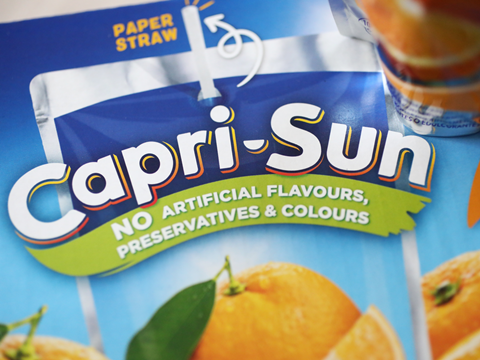
In a move that has sparked controversy, Capri Sun Group has called upon the European Commission to allow the re-introduction of its plastic straws to create a fully mono-material and recyclable pack.
The EU’s Single-Use Plastics Directive came into effect in July 2021. Under this legislation, single-use plastic straws are banned in most contexts.
Paper straws were first introduced for Capri Sun pouches in the spring of the same year. The move sought to save 400 tons of plastic a year; the brand also claimed to source its paper sustainably, partnering with environmental charity One Tree Planted to replant the same number of trees it used for its straws.
Back in January 2024, the company claimed to enhance the strength of its paper straws with 36% more bending force resistance, 42% more vertical compression resistance, and an 18% improvement in withstanding compression force.
Yet in March, the old Capri Sun pouch – made with laminated layers of aluminium, PE, and PET – was replaced with a mono-polypropylene alternative. The transition claimed to reduce CO2 emissions by 25% and contribute towards the brand’s goal of implementing fully recyclable packaging across its product lines.
Now Capri Sun Group directs consumers towards a Change.org petition urging the European Commission to permit the re-introduction of plastic straws for Capri-Sun drinks.
The post and petition read: “At Capri-Sun, we’re committed to innovating towards more sustainable solutions, whilst balancing convenience and functionality for consumers,” says the company in the petition’s description and a LinkedIn post. “We know that the switch to paper straws in 2021 hasn’t been ideal for many of you as it is less functional, and the pouch and paper straw need to be separated for recycling which is not always practical.
“Our old pouch was made of multiple materials and couldn’t be recycled. Earlier this year, we introduced a new pouch made from recyclable mono-material (PP).
“Our goal is to bring back recyclable plastic straws so that both the pouch and the straw can be recycled together. This way, you can dispose of both easily, without the paper straw polluting the recycling process.”
The announcement has incited backlash. Dirk Groot, litter analyst at Zwerfinator, is among the critics, asking: “What’s the use of a recyclable straw if we find so many of them on the streets and in nature? Recycling is no solution for plastic pollution. And if you care about recycling, first start making the pouches recyclable, don’t focus on the straws.”
Like Groot, several industry players have questioned the true recyclability of the Capri Sun pouch and criticized the company for focusing on a comparatively small component of the whole pack. Many have called upon the brand to back deposit schemes instead.
Nevertheless, consumers seem to consider the straw an essential facet of their drinking experience, regardless of its material. An Instagram post recently claimed that Capri Sun would distribute its drinks in 12oz bottles geared towards adults – a rumour that was quickly debunked – and although some responders were pleased that they would no longer need to “find the spot to poke the straw in and hope that it doesn’t come shooting back at you”, most complained that the drink “won’t be the same without the straw”.
In other news, retailer Morrisons intends to completely eliminate ‘problematic plastic’ and implement 30% recycled content across its own-brand primary plastic packaging by 2025, as per the UK Plastics Pact. It claims to have removed one billion single-use plastic items from its locations, including 80 million plastic straws from its cafes, drink cartons, and boxes of straws.
Additionally, independent McDonald’s franchisee Arcos Dorados Holdings is applying J&J Green Paper’s ‘all-natural’ barrier coating to its paper food packaging, including straws, in hopes of phasing out plastics, PFAS chemicals, and consumer waste.
If you liked this story, you might also enjoy:
How are the top brands progressing on packaging sustainability?
Sustainable Innovation Report 2024: Current trends and future priorities
Reuse vs. single use – which is better for the environment?
The ultimate guide to global plastic sustainability regulation


















No comments yet